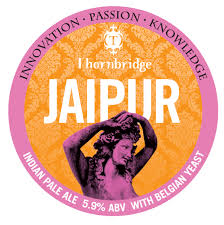Boak and Bailey's thoughts on where beer is heading in a 'post-craft' world spurred me to put down some disjointed ideas on the subject.
 |
| Jaipur - Ten years young in 2014 |
Considering a brief history of UK craft over the past decade, there have been a number of bold steps along the march of the 'craft beer revolution'. Thornbridge can't have been sure that a 5.6% IPA would have worked on a grand scale in 2004. Brewdog were probably flying a kite when they tried selling Punk IPA to Tesco. Kernel's offering of 7% dry-hopped IPAs and export stout was probably not the safest bet when they opened. Those breweries weren't necessarily innovating - in Kernel's case, the exact opposite - but they were slowly stretching out the drinker's tolerance of styles, flavours and ABVs.
The creation of that tolerance is what has led us to 2014's 'Year of Craft' - Sixpoint cans in Wetherspoons, big breweries running campaigns with the word 'craft' shoe-horned uncomfortably into the copy, and a brewery under every railway arch in the SE postcode. So what now?
.JPG) |
| Clarity - overrated or essential? |
The boldness of those breweries back in the last decade was in pushing the envelope of IBU count and ABV, which is an inherently limited exercise. (Despite often being characterised as juvenile, Brewdog had the sense to abandoning the facile eisbocking). They moved in the direction that they did because they wanted to create beers that they wanted to drink, and in doing so have popularised those beers with a wider audience.
If the 'craft revolution' was about prioritising flavour and aroma at the expense of appearance and, well, expense, perhaps the most successful brewers of the post-craft revolution will be those that can address the latter without sacrificing the former, and do it consistently. Some breweries are heading that way anyway.
I was intrigued to hear from
Andy Parker that Fourpure, one of the newest breweries in London, have set beer clarity as one of their most important principles. (I have yet to try any of their beer, but although their Pils is reportedly excellent, what I have heard of the rest of the range has not been great - so perhaps some work needed there.)
 |
| The Armoury - seen here before it went down the drain |
Further up the food chain, when Brewdog's lavish new brewery initially struggled to turn out two batches of Punk that were alike, they lost a lot of credibility. However, by the end of last year, the consistency was back - Jackhammer, in particular, is recognisable (and superb) from batch to batch. They even stunned everyone and dumped a batch of beer t
hat had been trailed extensively on their blog (The Armoury, a dry-hopped black lager) when it failed a QA test - something that they perhaps should have done with all that dodgy Punk in 2012... I think it's a sign that standards are important to the brewery now in a way that they clearly weren't a couple of years ago.
As 'craft' infiltrates Wetherspoons and the High St, expectations surrounding quality will rise accordingly. Uncarbonated batches, oxygen-riddled IPAs and gushing saisons are a surefire way to send the curious drinker back to their comfortable macrobrew. Post-craft needs to be defined by an ability to match the consistency of big beer. Big regionals like Thornbridge and Adnams, with their impressive brewplants, can manage it - the challenge for the small start-up breweries will be how that can be achieved through good process rather than through investment in equipment.
.JPG)
